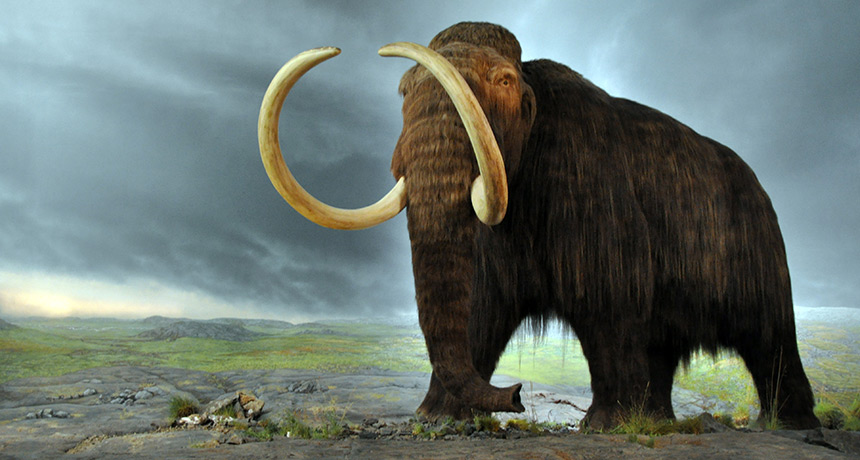De-extinction probably isn’t worth it

Some researchers are working on science that could one day resurrect extinct species, such as the woolly mammoth. Even if they’re successful, it is probably a bad idea because it would divert conservation money away from still-living species, a new study contends.
Flying Puffin/Wikimedia Commons (CC-BY-SA 2.0)
- More than 2 years ago
The prospect of resurrecting mammoths is back in the news after Harvard geneticist George Church announced last month that he may be only two years away from creating a mammoth-elephant hybrid fetus. That’s still a long way from a living mammoth — let alone herds of the animals — and scientists are skeptical that Church will be successful with even a hybrid fetus. The scientific hurdles that will have to be overcome are huge.
But the problems with de-extinction only start there. If resurrecting an extinct species is successful, scientists couldn’t stop at just one or two animals. They would have to make enough for at least one healthy-sized population. Then they would have to successfully reintroduce the species to the planet, taking care to find a place where the new-again species wouldn’t harm others and where the animals would be mostly safe from whatever drove them extinct in the first place. And those animals would then have to be managed and monitored for years.
All this costs big bucks, and it would divert already limited conservation funds away from species that have yet to go extinct but are badly in need of protection, Joseph Bennett, an ecologist at Carleton University in Ottawa, and colleagues warn in a new study. Whether government or private sources pay for such a reintroduction, other species are bound to suffer.
The financial costs of de-extinction are largely a mystery since no one has actually done it yet. But Bennett and his team wanted to get a handle on how much the reintroduction part of the process might cost — and how this might affect other conservation efforts. They turned to Australia and New Zealand for some examples.
“New Zealand and the Australian state of New South Wales are somewhat unique in the world in that they have very detailed prescriptions for all the actions necessary to save hundreds of their most threatened species,” Bennett notes.
The researchers looked for recently extinct species that were similar to living species that had conservation plans, such as the New Zealand falcon and Colenso’s forget-me-not. That let them estimate potential management costs for 11 extinct species in New Zealand and 5 in New South Wales if someone managed to resurrect them. There are no plans to bring back any of the species in the study, Bennett notes, but they make decent stand-ins for the idea in general.
The scientists then considered where the money for the reintroduction would come from. Either government agencies would handle the matter or it would be funded entirely by private sources. The researchers also considered whether those efforts could have benefits for other species in the ecosystem. For example, if successful reintroduction of a ground-dwelling bird required removing predators such as rats, that action would benefit other ground-dwelling birds in that area.
If the government had to pay for all of the costs, agencies would most likely have to divert money from other conservation efforts. And in nearly every case, that resulted in existing species losing out. Only for a small bird called the Forbes’ snipe could de-extinction potentially be a boon to other species. That’s because the actions necessary to successfully reintroduce it to the Chatham Islands off New Zealand would also benefit many of the other species that share its habitat on those islands. (Bennett warns, though, that more accurate cost estimates could erase such benefits.) For every other species considered for de-extinction, reintroduction would at best be neutral but at worst harm up to 14 existing species, the researchers report March 1 in Nature Ecology and Evolution.
If private sources footed the bill, they too would be spending money they could otherwise use for conserving other animals. So this approach would also have a cost, though not as steep a cost as with the diversion of government funds. However, introducing all five recently extinct Australian species would come at the cost of conservation efforts for 42 living ones, the researchers calculated.
But money isn’t the only part of this story. “When assessing whether or not to pursue de-extinction, calculating the conservation costs and benefits is not sufficient,” Northeastern University ethicist Ronald Sandler argues in an accompanying commentary. “It is also necessary to assess the ethical arguments for and against it — for example, those concerning justice, intrinsic value, cultural value and hubris,” he writes. For many species, the cons may add up so that de-extinction is truly a bad idea. There may be a rare species or two, though, for which there are great benefits to its return — so great that they outweigh any potential harm.
So perhaps it isn’t yet time to completely bury the idea of de-extinction. But it would seem like a good idea to consider all the pros and cons before investing millions of dollars into resurrecting something like the mammoth. Conservation funds are limited as it is. Perhaps we should devote more of them to saving the similar creatures, such as the elephant, that are still here but in great need of help.







